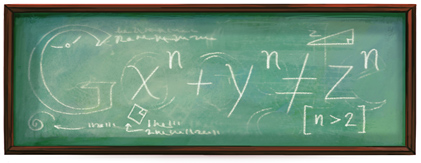
Pierre de Fermat was a mathematician in the 17th century who often doodled and wrote down mathematical ideas in the margins of his notebooks. Once he wrote down the theorem that bears his name, Fermat’s Last Theorem, shown in the Google Doodle above.
The doodle itself has a flaw I wish to point out. You see, Fermat never wrote down his theorem on a chalkboard. He couldn’t have since a chalkboard wasn’t invented until about 200 years after he had his insight and wrote down his theorem. He wrote his theorem in a notebook.
The reason a chalkboard is depicted in the doodle is that mathematics today is seen as an activity done on a chalkboard, probably by a professor or a teacher, and not something that students do.
I’d like to change that.
Shana Ray says:
LOVE this post. I am a sucker for all the Google Doodles. Though, are there teachers that even use chalk boards still?
August 17, 2011 — 12:43 am
David Wees says:
Chalkboard, whiteboard, Smartboard it’s really the same tool. In any case, the issue is not the chalkboard itself, but what it represents.
August 17, 2011 — 2:02 am
Cal says:
17th century 🙂
And I’m okay with chalk/white boards as they are public documents of student work when used effectively.
August 17, 2011 — 7:51 am
David Wees says:
Corrected, thank you.
Yes, absolutely, the tool can be used in effective ways.
August 17, 2011 — 9:47 am
Martin Goldberg says:
Well pointed out. If the media is the message, it actually is important that the idea be presented correctly. It adds a layer of authenticity for those who actually were interested in the idea being shared. For others it was likely immaterial.
September 13, 2011 — 5:30 pm